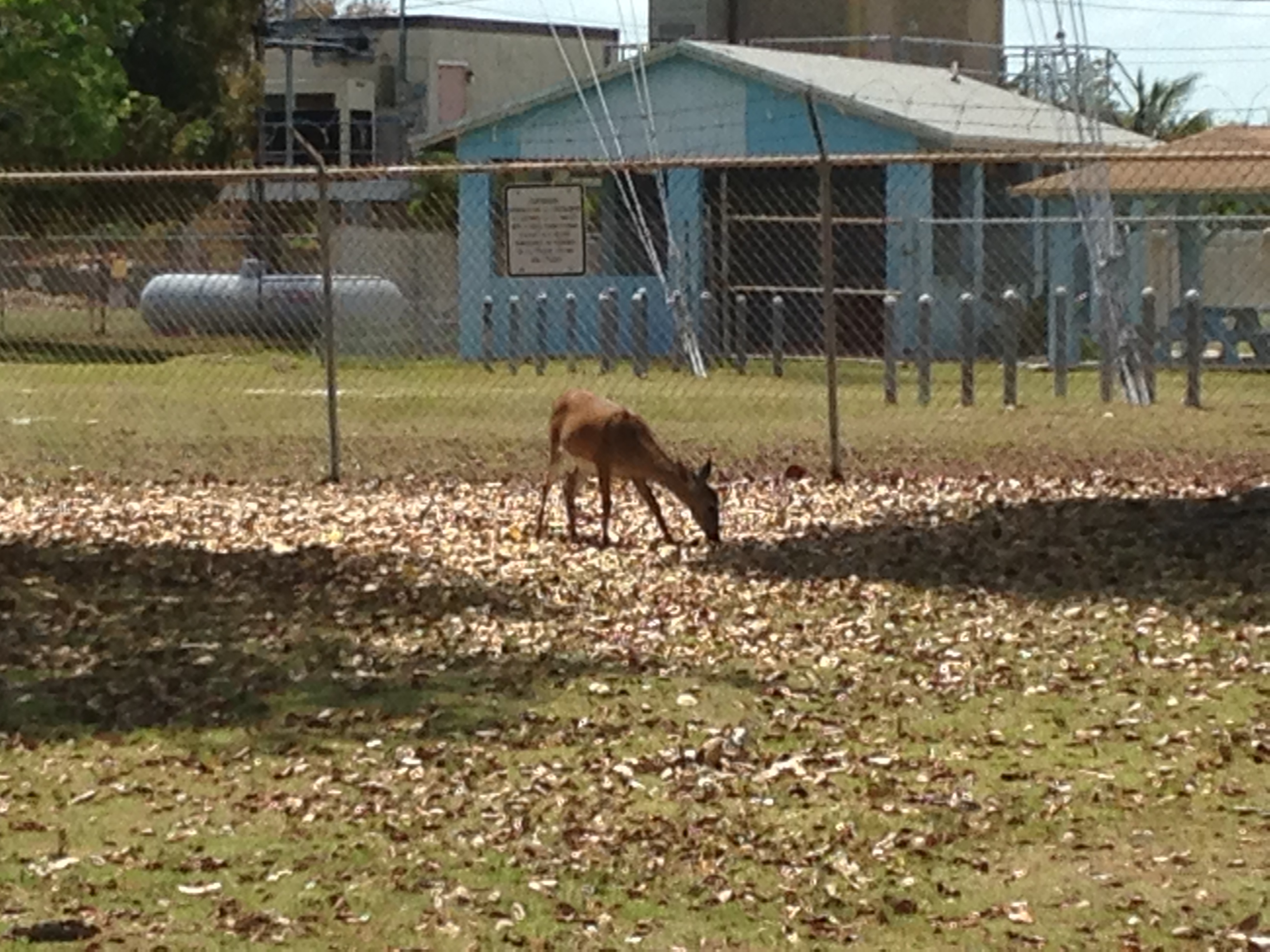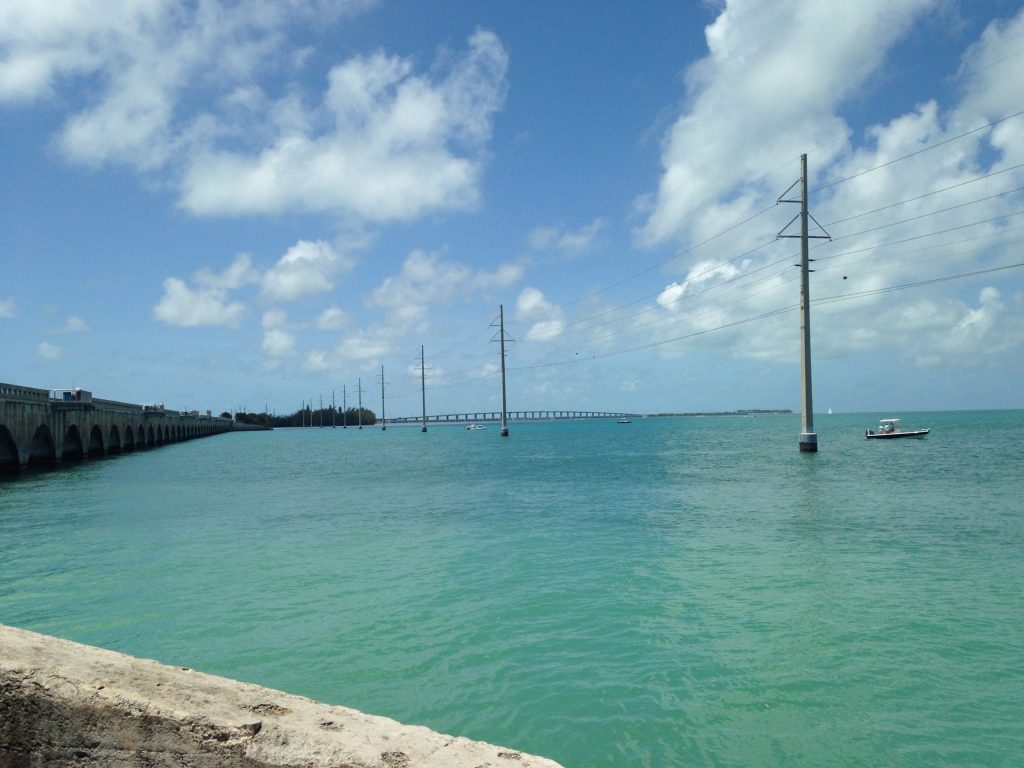My mom is a Florida resident. Visiting her is a convenient excuse to escape cold, gray winters. Several years ago, we decided to take a drive to Key West. Neither of us had ever been. We set a course for Margaritaville (cool island breezes, free flowing adult beverages, and a flip-flop attitude).
Route 1 South leads you straight to carefree island living. No twists or turns to remember. Simple – just like island life. We crossed from the mainland onto Key Largo. Almost there! If you have ever driven to Key West, the wave of happiness that hits you when you span The Overseas Highway is tangible. You immediately begin to hear Bertie Higgins singing in your head. Aaaahhhh…
Then you realize you have another 2+ hours and 100 miles to reach your island paradise. Oh the humanity!
Plantation Key, Islamorado, Duck Key, Marathon – all that sunshine and crystal blue water is rather intoxicating but everything looks the same.
And then you get to Big Pine Key. All at once you have entered a weird tropical penitentiary.
High fence lines the highway.
I was a bit taken aback until I saw the flashing speed limit and deer signs. Big Pine and No Name Key are home to about 75% of the population of endangered Key deer (Odocoileus virginianus clavium), the smallest subspecies of white-tailed deer. Bucks top out at 85 lbs standing about a meter high at the shoulder. Does only average about 65 lbs. Numbering only a few dozen in the 1950s, the population is estimated to be less than 1,000 animals today.
The biggest threat to these tiny deer – you guessed it, vehicles! Each year 5-15% of the population is lost to deer-vehicle collisions. I now understood why a very large fence was obstructing my endless view.
Suddenly I was a deer biologist (not a tourist) in the middle of a population of endangered deer. I had to see one. Exit Overseas Highway, stage right! I was giddy with anticipation, my mother not so much.
We drove around for what seemed like not very long; however, to my mother, it was apparently an eternity. My mother’s impatience with our detour was adding to my anxiety. I was trying to peek in every mangrove thicket we passed while keeping rental car on the pavement. I decided to call off the search and head back to Route 1 when my mother asked, “Well, what do they look like?” “Like little deer!” I said. “You mean like that?” she asked as she pointed out the window.

And there she was…in the grass just off the side of the road in front of an unattractive chain-link fence and blue cinder block building. Not quite what I was expecting. But a Key deer nonetheless! Mission accomplished, we continued on our way to the southernmost point in the U.S.
That was in 2015. Key deer have had a pretty rough go of it since then. In 2016, New World screwworm was confirmed in deer on Big Pine Key. Screwworms infect livestock and other warm-blooded animals, including people. Nasty little buggers that eat living flesh. Animals not treated in 7-14 days may die. It was a big problem for the little deer on Big Pine. There were 135 confirmed Key deer mortalities as a result of screwworm infestation – over 10% of the entire population!
New World screwworms exist throughout South America but were eradicated from the entire Southeastern U.S. in 1959. Today, the USDA and its partners maintain a permanent sterile fly barrier at the Darien Gap between Panama and Colombia to prevent the establishment of any screwworm flies that enter from South America. But somehow, they made their way to Big Pine Key. It was an all out effort by the USFWS, USDA, Florida Department of Agriculture and Consumer Services, and the local community to treat Key deer with the anti-parasitic to control the outbreak. Treatment and eradication were a success and the screwworm mortality event ended by January 2017. The Key deer population appeared to be stable.
Whew! Crisis averted. But when it comes to endangered species, life is a crisis. That’s why they are endangered.
Then came the 2017 hurricane season. Screwworm crisis straight to Hurricane Irma catastrophe.
Hurricane Irma was a Category 4 storm when the eye passed over every Key deer on earth on September 9, 2017. Because of the New World screwworm outbreak just a year before, road surveys were conducted along standardized route to obtain an index to population size and density. And there were several Key deer still radio collared from the disease monitoring.
The post-Hurricane Irma status report conservatively estimated a 22% decrease in the Key deer population. Deer are amazing and Key deer are no different. White-tailed deer found themselves stranded on the Florida Keys at the end of the last Ice Age (about 10,000 years ago). As we know, whitetails have a “never say die” attitude. Now genetic divergence makes them a distinct subspecies adapted to a salt-tolerant island lifestyle. The first beach bum of the Keys, if you will.
But Hurricane Irma was not the first Category 4 storm to hit the Keys or Key deer in the last 10,000 years. Key deer weathered those storms but the times, they are a-changing.
Unregulated hunting followed by habitat loss placed this species on the endangered list. Today there are less than 1,000 of these critters left…in the world. Endangered means in danger of extinction throughout all or a significant portion of a species’ range.
A direct hit by Irma removed 1/5 of the population but not all of it. That is amazing and testament to how tough deer are. Climate change will likely cause tropical cyclones globally to be more intense on average as this century wears on. Throwing more curve balls at the Keys. Curve balls are something Key deer can handle. But they can’t play ball if there is no field!
While Key deer are endangered, their density is extremely high. The total area of Big Pine and No Name Key is about 11.6 square miles. The conservative post-Irma population estimate of Key deer was 759. That’s over 65 deer/square mile. Yikes!
The Key deer population has responded very well since their protection in 1967 (remember less than 50 remained then). These tiny deer patrol neighborhoods going through trash, getting hit by cars and terrorizing neighborhoods – common deer problems. When density is that high, good habitat is essential to supporting healthy populations.
The real problem for Key deer today is habitat loss. And when I say loss, I mean gone forever. Swallowed up by the sea.
Another nasty side effect of climate change is sea level rise. The seas are rising and sea level rise predictions indicate that many of the primary sources of freshwater for the Key deer will likely be seasonally or permanently inundated with saltwater by 2100. Key deer may be salt-tolerant but they still need fresh water.
Rising seas are shrinking the already limited available habitat and higher storm surges will damage what is left.
How will Key deer abundance affect the habitat that remains?
Wait a minute – deer abundance, habitat impacts. That sounds awfully familiar. The Deer-Forest study doesn’t have to worry about rising sea levels, storm surges, or an endangered subspecies but we are concerned with deer-habitat interactions (among others) and how they affect rest of the environment.
Given the issues Key deer face, I doubt Pennsylvania deer are jealous of their beach bum cousins…except maybe for that ocean view.
Wildlife Biologist
If you would like to receive email alerts of new blog posts, subscribe here.
And Follow us on Twitter @WTDresearch
